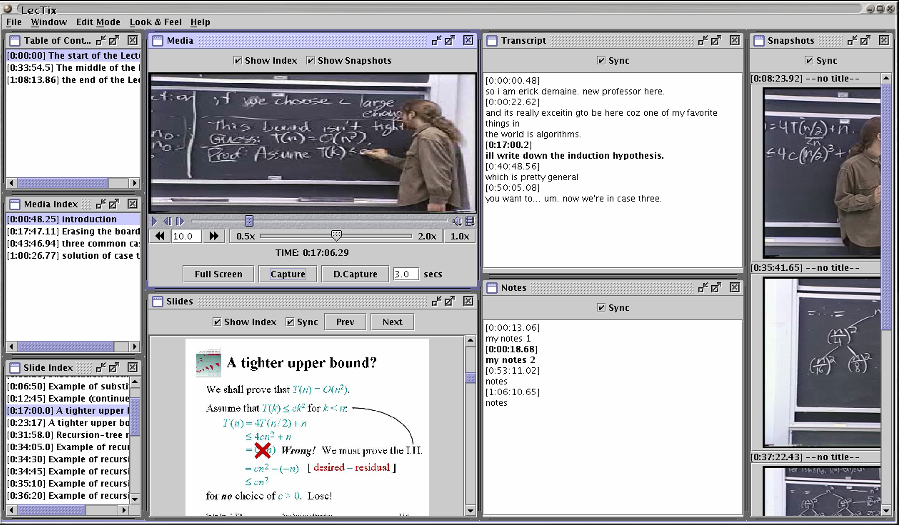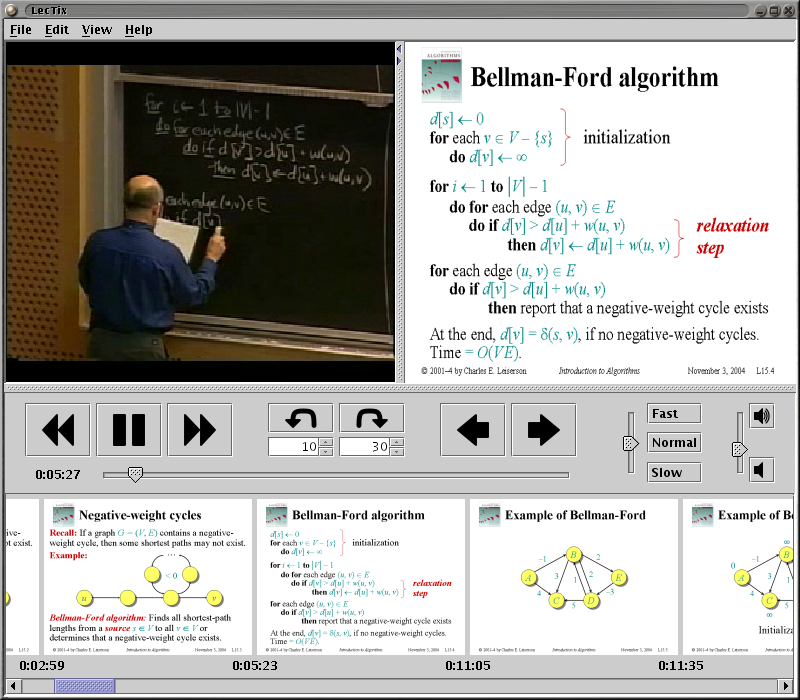LecTix: A Lecture-Multimedia Player and Producer
Timothy Olsen
Introduction
Lecture-multimedia players play an integral role in distance-education today. While not able to perfectly replicate the experience of attending a live lecture, lecture-multimedia players offer enhancements to the lecture-viewing experience otherwise not available in an in-person lecture.
Most lecture-multimedia players today depend on closed video-playback plugins such as Windows Media [6] or RealPlayer [8]. Such plugins limit the feature set, portability, and distribution of the lecture-multimedia players. Only recently have open and royalty-free codecs [1,9] started to emerge that will form the basis for open video-playback plugins.
Background: the SMA case
The Singapore-MIT Alliance (SMA) is an educational and research collaboration among the National University of Singapore, the Nanyang Technological University, and MIT. Students can attend lectures remotely by watching them on RealPlayer. The lecture presentation consists of the lecture video and synchronized slides (see Figure 1).
The player shown in Figure 1 is lacking some basic features that may enhance the lecture-viewing experience: rewind, fast-forward, and a list of slide titles or thumbnails for navigation. Moreover, we believe adding some more advanced features may further aid the viewer as well as the producer: variable-speed control with pitch normalization, a transcript, a notepad, a frame grabber, and editing capabilies.
LecTix 1.3
To remedy this problem, we developed LecTix [7] (previously known as LectureViewer [2] or EVES [5]), a lecture-multimedia player which implements our desired features. LecTix 1.3 is shown in Figure 2.
We prepared lectures in the LecTix 1.3 format for students in the class An Introduction to Algorithms, and offered the LecTix 1.3 player for them. To keep production costs down, we did not offer a transcript.
Looking over the server logs, there were, on average, about 4 times more downloads of the lecture video by itself than downloads of the combined lecture multimedia (video and slides). We interpreted this to mean that many students were downloading the video to watch it on a player other than LecTix. Otherwise, they would have downloaded the complete multimedia.
In speaking with students, we discovered that we added features, and hence extra windows, at the expense of the size and benefit of the video and slides. User testing of the interface showed that the functions of some of the controls were not obvious---possibly due to the reduced information given their small size.
LecTix 2.0
With this feedback in mind, we designed and implemented LecTix 2.0. LecTix 2.0 is shown below in Figure 3.
The revised interface places the video and current slide side by side to take advantage of the human visual system's horizontal bias. Slide navigation is still accomplished by scrolling through a filmstrip of slides, but this time the filmstrip is displayed horizontally with timestamps, and with enough space to see several thumbnails at once. A separate text index is no longer needed, saving screen real estate as well as production work.
In addition, we took out the control panel provided by JMF and inserted our own. This new control panel adds controls for rewinding, fast-forwarding, separate configuration for skipping forward and backwards, shortcuts for three speed settings, and the volume control is no longer hidden behind a single button.
The internal architecture was also improved by implementing it with modular media components. A custom event mechanism was added in order to decouple separate media components. LecTix 1.3's clumbsy collection of configuration files were combined into one XML file. New media components can be compiled separately and loaded on demand by the configuration file.
Future Work
Early feedback tells us that LecTix 2.0's interface is an improvement over that of LecTix 1.3, but there is still room for improvement.
Many consider the new controls to be too big. We would like to make the size of the controls customizable.
Many of LecTix 1.3's useful features are missing, such as a transcript, notepad, frame grabber, and editing capabilities. We would like to investigate ways to add these features without wasting screen real estate when they are not in use. One suggestion was to implement preset layouts, such as in Eclipse. We would also like to add editing capabilities via direct manipulation; instead of having a separate button to click to edit a time-stamp, just make the time-stamp directly editable.
LecTix 2.0 continues to use the same video codec used in LecTix 1.3: MPEG-1 [4]. This video codec does not provide adequate quality below around 800Kbps---a bitrate unstreamable for most users. We are currently investigating the feasibility of replacing MPEG-1 with H.263 [3] or Ogg Theora [9].
Acknowledgements
Luis F. G. Sarmenta, Charles Leiserson and the MIT Supercomputing Technologies group provided invaluable feedback on the design of LecTix 2.0.
This research is supported in part by the Singapore-MIT Alliance and NFS Grants ACI-0324974 and CNS-0305606.
References:
[1] British Broadcasting Corporation. Dirac. http://www.bbc.co.uk/rd/projects/dirac/index.shtml
[2] Kai Huang, Charles E. Leiserson, and Luis F. G. Sarmenta. A Media Player for Use in Distance Education. Singapore-MIT Alliance. November, 2003. http://dspace.mit.edu/retrieve/3725/CS029.pdf
[3] International Telecommunication Union. H.263: Video coding for low bit rate communication. http://www.itu.int/rec/recommendation.asp?type=folders&lang=e&parent=T-REC-H.263
[4] ISO/IEC 1993. ISO/IEC 11172-1993: MPEG-1 coding of moving pictures and associated audio at up to about 1.5 Mbits/second.
[5] Marco Dolcetto Mate, Darlene Mari Velasquez, and Luis F. G. Sarmenta. An enhanced Lecture Viewer for eLearning. In 3rd National Conference on eLearning
[6] Microsoft. Windows Media. http://www.microsoft.com/windows/windowsmedia/default.aspx
[7] MIT CSAIL Supercomputer Technologies Group. LecTix. http://www.lectix.org
[8] RealNetworks. RealPlayer http://www.real.com
[9] Xiph.Org Foundation. Ogg Theora. http://www.theora.org
The Stata Center, Building 32 - 32 Vassar Street - Cambridge, MA 02139 - USA tel:+1-617-253-0073 - publications@csail.mit.edu (Note: On July 1, 2003, the AI Lab and LCS merged to form CSAIL.) |



